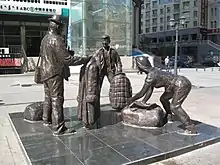
Shuttle traders (Russian: челноки, romanized: chelnoki, lit. 'shuttles'; Ukrainian: човники, romanized: chovniki) were people engaged in the practice of shuttle trading in late Soviet Union and post-soviet states in which traders shuttle backwards and forwards in and out of the country buying goods and then selling them within the country.[1] Originated during the perestroika times, it extended well beyond time of the collapse of the Soviet Union in Russia, as well as in many other post-Soviet states.[2][3][4][5][6]
In Turkey the practice of shuttle trading is known as "suitcase trade" (Turkish: Bavul ticareti) since 1960s when goods for sale were brought from Northern Cyprus in suitcases, hence the term.[7]
The OECD defines shuttle trade as "the activity in which individual entrepreneurs buy goods abroad and import them for resale in street markets or small shops. Often the goods are imported without full declaration in order to avoid import duties."
See also
References
- ↑ "ПРАВДА.info - Ода "челнокам"". www.pravda.info. Retrieved 2018-11-25.
- ↑ "Кто такие "челноки": откуда взялись и куда подевались?". shkolazhizni.ru. Retrieved 2018-11-25.
- ↑ Lidia Lukyanova, HOW THE SHUTTLE TRADERS SAVE RUSSIA, 1997
- ↑ Igor Rotar, MERCHANTS PROTEST NEW BANKING LAWS IN UZBEKISTAN, 2004
- ↑ Grigory Ioffe, A Business and a Pep Talk, 2013
- ↑ TURKEY’S CULTURAL AND ECONOMIC PRESENCE GROWS IN KYRGYZSTAN, 2007
- ↑ Yüksek Lisans Tezi TÜRKİYE’DEKİ BAVUL TİCARETİ GELİŞMELER VE YENİ ALTERNATİFLER , 2007
External links
- Zabyelina, Y. (2012). “Costs and Benefits of Informal Economy: Shuttle Trade and Crime at Cherkizovsky Market.” Global Crime, Volume 13, No. 2, pp. 95-108. (behind the paywall)